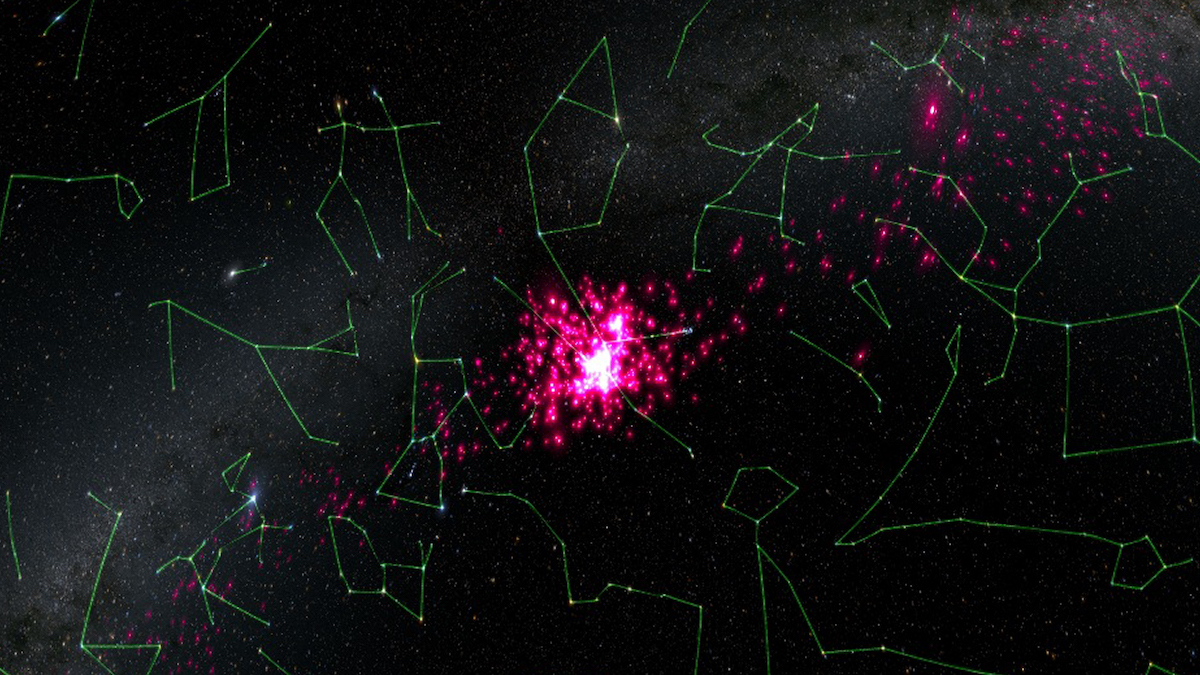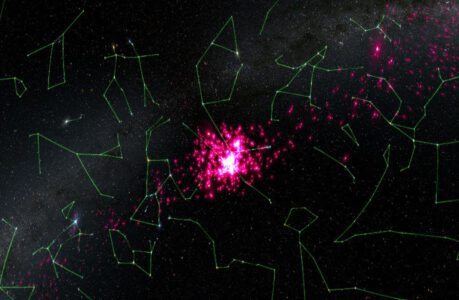Hyades Cluster, a star cluster located in the Taurus constellation, is one of the brightest and closest open clusters to Earth. It is named after the Greek mythological nymphs, the Hyades, who were the daughters of Atlas and half-sisters of the Pleiades. This cluster is a fascinating and significant object for both astronomers and skywatchers.
The Hyades Cluster is believed to be around 625 million years old and consists of more than 100 stars. Its brightest stars form a distinctive V-shape in the Taurus constellation, which can be seen with the naked eye. The brightest star in the Hyades is Aldebaran, a red giant that appears to be a part of the cluster but is actually a foreground star.
This star cluster has played an essential role in astronomical research, particularly in determining the distance to the stars. Astronomers have used it as a benchmark for measuring the brightness and distance of other celestial objects. In the early 19th century, Sir William Herschel used the Hyades to derive the first estimate of the distance to the stars. He also discovered several white dwarfs in the cluster.
The Hyades Cluster also has a significant cultural and mythological history. The ancient Greeks associated the Hyades with the rainy season and believed that the cluster caused the rain. It was also regarded as the bull’s face, which is why it was a significant constellation in the zodiac. In Hindu mythology, it was known as the Rohini Nakshatra and was believed to be the favourite wife of the moon.
To observe the Hyades, one needs to look towards the Taurus constellation. The best time to view the Hyades is during the winter and spring months in the northern hemisphere. One can easily spot the cluster with the naked eye, and with a pair of binoculars or a telescope, it’s even more spectacular. The Hyades Cluster is a must-see for all skywatchers and astronomy enthusiasts.
Hyades cluster in mythology
The Hyades are a group of stars in the constellation Taurus, named after the Greek mythological nymphs. In Greek mythology, the Hyades were the five daughters of the Titan Atlas and the Oceanid Pleione. They were half-sisters of the Pleiades, another star cluster in the same constellation.
The Hyades were associated with the rainy season and were believed to cause rain. In some versions of the myth, the Hyades were transformed into stars by Zeus after they mourned the death of their brother, Hyas. In other versions, the Hyades were transformed into stars by their father, Atlas, in order to protect them from the wrath of Zeus.
The Hyades were often depicted as weeping, with their tears falling to the earth as rain. They were also associated with wine, as their tears were believed to nourish the grapevines. The Greeks believed that the Hyades were the nurses of Dionysus, the god of wine, and that they were responsible for his education.
The Hyades were an important part of Greek astrology, and were associated with the zodiac sign Taurus. In Hindu astrology, they were known as the Rohini Nakshatra, and were believed to be the favourite wife of the moon.
Today, the Hyades continue to fascinate astronomers and skywatchers alike. They are one of the closest open clusters to Earth, and can be easily seen with the naked eye. The cluster is made up of more than 100 stars, and its brightest stars form a distinctive V-shape in the Taurus constellation. The brightest star in the Hyades is Aldebaran, a red giant that appears to be a part of the cluster but is actually a foreground star.
The Hyades have played an important role in astronomy, particularly in determining the distance to the stars. Astronomers have used the Hyades as a benchmark for measuring the brightness and distance of other celestial objects. Today, the Hyades remain a fascinating object for both astronomers and those who appreciate the beauty and mythology of the stars.
What is a star cluster
A star cluster is a group of stars that are gravitationally bound and located close to each other in space. Star clusters can be classified into two main types: globular clusters and open clusters.
Globular clusters are densely packed groups of stars that are typically located in the outer regions of galaxies. They can contain anywhere from thousands to millions of stars and have a spherical shape. Globular clusters are thought to be some of the oldest objects in the universe, with some dating back more than 10 billion years.
Open clusters, on the other hand, are looser groups of stars that are typically located in the spiral arms of galaxies. They typically contain a few hundred to a few thousand stars and are often irregular in shape. Open clusters are generally younger than globular clusters, with ages ranging from a few million to a few billion years.
Star clusters are important objects for astronomers to study because they provide insights into the formation and evolution of stars and galaxies. By studying the properties of stars in a cluster, astronomers can learn about their ages, compositions, and distances from Earth. Star clusters can also be used as standard candles to measure the distances to more distant objects in the universe.
How can I find Taurus?
The constellation Taurus is one of the most recognizable constellations in the night sky. Here are a few steps you can follow to find Taurus:
- Find Orion: The easiest way to find Taurus is to first locate the constellation Orion. Orion is another prominent winter constellation that is easy to spot. Look for the three bright stars in a row that make up Orion’s Belt.
- Look for the V-shape: Once you have located Orion, look for a bright V-shaped pattern of stars to the upper right of Orion’s Belt. This is the head of Taurus, with the bright orange-red star Aldebaran marking the eye of the bull.
- Find the horns: Next, look for two stars that make up the horns of the bull. These stars are located to the left and right of the head of Taurus.
- Look for the Pleiades: Finally, look for the Pleiades, a star cluster located to the right of Taurus. The Pleiades are a group of bright, blue stars that are also easy to spot.
Remember that Taurus is a winter constellation in the northern hemisphere, so it is best viewed in the months of December through March. It is visible in the evening sky from November through May. Good luck and happy stargazing!

